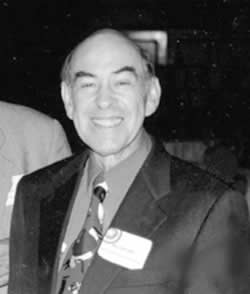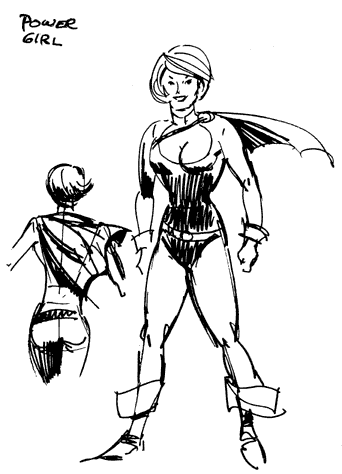All The Stars There Are in (Super-hero) Heaven!
The 1970s Justice Society Revival-All-Starring the Original Cast!
by Roy Thomas
RIC ESTRADA
(Layout Penciler, All-Star Comics #58-59)
Transcribed by Brian K. Morris
From Alter
Ego Vol. 3 #14
In Alter Ego #14, you'll find Roy's take on the 1970s JSA revival. You can
find mini-interviews with some of the other participants: Paul
Levitz, Gerry Conway, Ric
Estrada, Keith Giffen, Al
Milgrom & Joe Staton.

A recent photo of Ric Estrada, courtesy of the artist. RT: Ric, you're noted for your war comics work alongside Kanigher, Kubert,
Andru, Heath, et al., on DC's "Big Five" war comics, as Chris Pedrin
called them in his book a few years back. You haven't drawn many super-heroes,
so why do you think writer/editor Gerry Conway asked you to pencil the revival
of All-Star Comics in 1975?
RIC ESTRADA: I think it may have been because my style was very direct
and very simple-plus I happened to be available at the time. I did a lot of
romance stories, war stories, mystery stories... but no, I didn't do many super-heroes,
though I did do Legion of Super-heroes and Super Friends and one issue of Batman.
RT: I know Gerry was very happy with the work, because I saw a lot of
him at that time in New York. How did you feel about the idea that Wally Wood
was going to ink the book?
ESTRADA: Very happy, because Wally Wood is one of the big names in the
industry. I think everybody admires him and loves his work. I felt that would
enhance the value of my work, and it did. Years later, when I did Richard Dragon,
Kung-Fu Fighter, and I sold the original art, the ones I inked would sell for
something like fifty bucks, and the only one he inked sold for like a hundred
and fifty. [laughs]
RT: It was a happy combination. Did you ever meet Wally personally in
connection with this book or at any other time?
ESTRADA: You know how it was: you freelanced in those days, and you came
to the editorial office and you met people for half an hour, you chatted for
a while, and then you didn't see them for another three years. I kept meeting
people over the years. I remember meeting Neal Adams almost every week; he worked
at DC and had this little office there. And I met people like Joe Orlando and
Carmine Infantino; they were always there.
But Wally Wood-I would run into him and say hello and say good words and that
was it. I also knew Wally from the EC days, way back in 1950, '51.
RT: Joe Orlando is often credited with designing Power Girl, maybe from
Gerry Conway's suggestion. But the only design sketch I've ever seen was one
you did that DC ran in its fan-magazine Amazing World of DC Comics. Do you remember
how that character was designed?
ESTRADA: Not the exact details, but I do know they liked the way I drew
women, because I had done a lot of romance stories. In fact, the first year
I worked for DC, I did mostly the romance line. I drew girls sexy but not too
muscular like they became later.
RT: Of course, Wally was noted for his females, too, so the inking worked
out between the two of you. She had a very sexy outfit.
ESTRADA: And she was kind of a hefty girl. She was not a slinky girl.

We printed this Estrada concept sketch of Power Girl from Amazing World of DC
Comics #6 (1975) two issues ago, but we just had to repeat it here! So how did
that bare circle on Kara's chest get smaller and, well, centralized? [©2002
DC Comics.]
RT: Do you recall what kind of reference they gave you to start on All-Star?
ESTRADA: They gave me a couple of comic books from the '40s, and they
said, "Do your own stuff, based on this." So what I did is I updated
the style. The styles of the '40s and '50s were a little more, I would say,
primitive. And by the '60s and '70s, we were a little more refined, not in drawing
structure, but in line-handling.
RT: You probably won't remember the main villain-Brainwave. In the old
comics, he appeared in several issues and he was just a guy with a scientist's
smock and a great big bald head. But in your two issues he ends up as a more
modern-style, costumed villain. Another old villain, Degaton, appeared in your
second issue, and he was altered, too.
ESTRADA: I think they gave me a prototype for the costume and I sort
of slicked it up a bit. Usually, they would give you some kind of a sketch that
the editor or one of the staff artists would do, and you'd follow that.
RT: In your second story [#59] you're listed as "Designer"
instead of "Penciler." What did that mean? It says, "Ric Estrada,
Designer; Wally Wood, Artist." Did you do less finished pencils on the
second one? On the first, you're listed together as "Artists."
ESTRADA: It was a kind of an iffy thing that I never quite understood.
If you did finished pencils with shading and everything, they called you a "penciler"
or "artist." If you did layouts that were a little more unfinished
and fast, they called you a "designer"-and I think that's what happened-that
they needed a book fast, and I drew it without any frills. They knew Wally Wood
was going to ink it, so I didn't have to put in too many details and shading.
But my structures and compositions were very complete.
RT: They wanted you mostly for the storytelling.
ESTRADA: Exactly. And that's been my strength most of the time. All my
life, storytelling is my forte.
RT: Do you remember whether you worked "Marvel style," from
a plot-or did you work from a full script?
ESTRADA: I have the recollection that I worked from a full script. I
don't think DC did too many of the Marvel style. Gerry may have been asked to
write a full script. I do remember that, once in a while, DC Comics would give
me a script and say, "We don't know what to do with it. There's a good
story but it's not well-written. Would you rewrite it?" I would rewrite
it, but there was always a script.
RT: Why did you leave the book after two issues?
ESTRADA: I think they just assigned me to something else. I was working
with Murray Boltinoff on his war comics, and with Joe Kubert, and they knew
that's what I did best. I put my heart into the war comics. To me, super-heroes
were interesting but infantile. [laughs] The war stories-there was a reality
to them that I enjoyed very much. Even though my art is very stylized, I believe
in the realism of the story.
RT: You didn't work on either of the covers for your two issues of All-Star.
ESTRADA: I've only done one cover for DC Comics-and it was when I started
with them and I was doing romance. They liked my style very much, and Carmine
Infantino gave me a cover to do. And he bet, I don't know, fifty bucks, a hundred
bucks, that issue was going to outsell every other issue-and he lost. [laughs]
He never gave me another cover. I loved the guy, but because I had a very slick
girlie style, he thought that cover was going to really sell with the little
girls. After that, I said, "When am I going to get another cover?"
And I never did get another one.
RT: Do you remember anything else in connection with that time?
ESTRADA: Well, I just remember working with Gerry Conway, and he was
fine to work with. But something that always kind of rattled me a little bit
was that he made a little fun of my accent, and I'm very touchy about my accent.
I grew up in Cuba and I came to the US in my teens, and I still kept a little
sound that is not quite the same as a New Yorker's, or whatever. A couple of
times Gerry made fun, but we got along beautifully, because he was a very talented
man and he wrote beautifully.

Sign up here to receive periodic updates about what's going on in
the world of TwoMorrows Publishing.

Click here to download
our new Fall-Winter catalog (2mb PDF file)
Howard Keltner's Golden Age Comic Books Index is the premier
references for Golden Age comics! Bob Klein worked with Howard
to make this edition available, just before Howard's untimely death
in 1998. Howard's widow has graciously given us permission to give
the index away for free for all to enjoy! Click
here to view! (1.5 MB file. Adobe
Reader required.) |